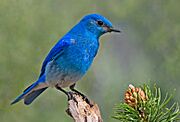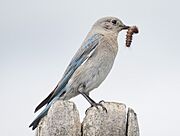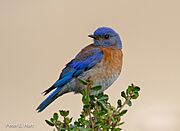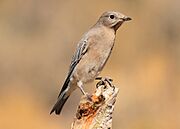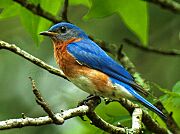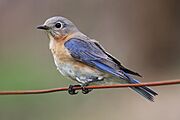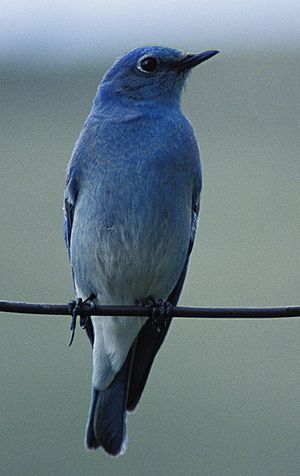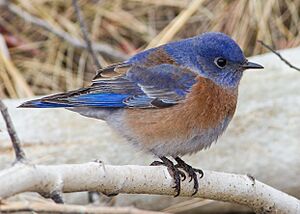Bluebird facts for kids
Quick facts for kids Bluebirds |
|
|---|---|
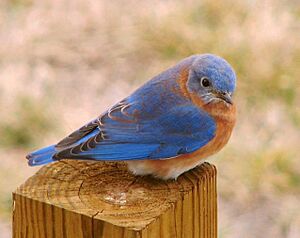 |
|
| A male Eastern bluebird in Texas | |
| Scientific classification |
|
| Kingdom: | Animalia |
| Phylum: | Chordata |
| Class: | Aves |
| Order: | Passeriformes |
| Family: | Turdidae |
| Genus: | Sialia Swainson, 1827 |
| Type species | |
| Motacilla sialis Linnaeus, 1758
|
|
| Species | |
|
|
The bluebirds are a group of medium-sized birds found in North America. They belong to the genus Sialia within the thrush family. Bluebirds mostly eat insects, but they also enjoy other foods like fruits. They are one of the few types of thrushes that live in the Americas.
Bluebirds usually lay 4 to 6 eggs at a time. They can raise two or three families of chicks each year. Their nesting season typically runs from March to August.
These beautiful birds have blue feathers, sometimes mixed with rose-beige colors. Female bluebirds are a bit less brightly colored than males, but their feather patterns are similar. Both male and female bluebirds are about the same size.
Contents
Discovering Bluebird Species
The group of birds called Sialia was first described by an English scientist named William Swainson in 1827. The Eastern Bluebird is considered the main example of this group. Scientists have studied bluebird DNA to understand their family tree. They found that bluebirds are related to other thrushes.
There are three main species of bluebirds:
| Common name | Scientific name and subspecies | Range | Size and ecology | IUCN status and estimated population |
|---|---|---|---|---|
| Mountain bluebird | Sialia currucoides (Bechstein, 1798) |
Western North America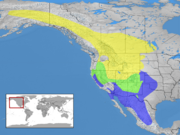 |
Size: 15.5–18 cm (6.1–7.1 in) Habitat: ubiquitous in mountain environments, but also in open country Diet: various arthropods in summer and a variety of fruit in winter |
LC
|
| Western bluebird | Sialia mexicana (Swainson, 1832) Six subspecies
S. m. occidentalis Townsend, JK, 1837
S. m. bairdi Ridgway, 1894 S. m. jacoti Phillips, AR, 1991 S. m. amabilis Moore, RT, 1939 S. m. nelsoni Phillips, AR, 1991 S. m. mexicana Swainson, 1832 |
California, the southern Rocky Mountains, Arizona, and New Mexico in the United States, and as far south as the states of Oaxaca and Veracruz in Mexico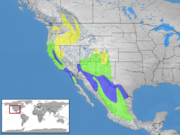 |
Size: 15–18 cm (5.9–7.1 in) Habitat: light woodland, but has adapted to coniferous forests, farmlands, semi-open terrain, and desert Diet: omnivorous, including aerial and terrestrial insects |
LC
|
| Eastern bluebird | Sialia sialis (Linnaeus, 1758) Seven subspecies
S. s. sialis (Linnaeus, 1758)
S. s. bermudensis Verrill, AH, 1901 S. s. nidificans Phillips, AR, 1991 S. s. fulva Brewster, 1885 S. s. guatemalae Ridgway, 1882 S. s. meridionalis Dickey & Van Rossem, 1930 S. s. caribaea Howell, TR, 1965 |
East-central southern Canada to the US Gulf states, and southeastern Arizona to Nicaragua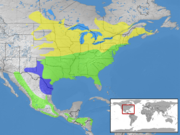 |
Size: 16–21 cm (6.3–8.3 in) Habitat: open country around trees, with little understory and sparse ground cover, expanded range to human-altered habitats Diet: mainly insects and other invertebrates, but also fruit and berries |
LC
|
Bluebird Behavior and Life Cycle
Bluebirds like to have their own space and prefer open grassy areas with a few scattered trees. This is similar to how some woodpeckers behave. They usually raise two to four families of chicks each spring and summer.
Male bluebirds find good spots for nests. They try to attract female bluebirds by singing, flapping their wings, and putting nesting material into a box or hole. If a female likes the male and the spot, she builds the nest and sits on the eggs by herself.
Young bluebirds in their nests can be hunted by animals like snakes, cats, and raccoons. Other bird species, such as common starlings, American crows, and house sparrows, sometimes compete with bluebirds for nesting spots. These birds might take over bluebird nests, which can harm the bluebird eggs and chicks.
Bluebirds enjoy eating mealworms (which are actually beetle larvae) from bird feeders. They also like raisins soaked in water. In winter, they sometimes use heated birdbaths in backyards.
By the 1970s, the number of bluebirds had dropped a lot, by about 70%. This happened because they had trouble competing for nesting spots with other birds like house sparrows and starlings, which were brought to North America from other places. Also, their natural homes were shrinking. But good news! By late 2005, scientists at Cornell University reported that bluebird numbers were growing again, especially in the southern U.S. This comeback is thanks to many volunteers who built and looked after special "bluebird trails" with nesting boxes.
Bluebirds in Your Garden
Bluebirds are helpful to gardeners because they eat many insects. This makes them a welcome visitor in many backyards.
Bluebirds in Culture and Songs
Iroquois Stories
In the traditional stories of the Iroquois people, the bluebird's song was believed to scare away Sawiskera, also known as Flint, who was the spirit of winter. When the bluebird sang, Sawiskera would leave, and the ice would melt.
Bluebirds in Music
Bluebirds have inspired many songs:
- "Bluebird of Happiness" is a famous song from 1934.
- "(There'll Be Bluebirds Over) The White Cliffs of Dover" was written in 1941 during World War II. This song looked forward to a time when the war would be over. It became very popular through performances by Vera Lynn for soldiers. The songwriter didn't know that bluebirds don't actually live in England!
- "Bluebird" is a rock song written by Stephen Stills and recorded by the band Buffalo Springfield in 1967.
See also
 In Spanish: Sialia para niños
In Spanish: Sialia para niños
- Bluebird of happiness


